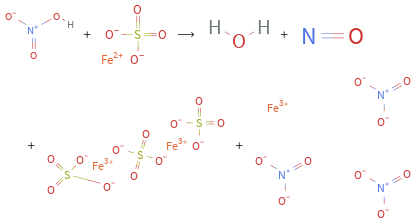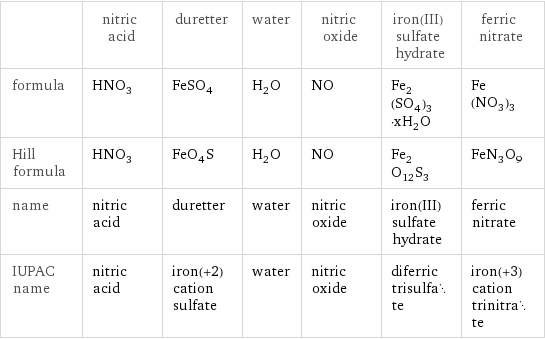Input interpretation

HNO_3 nitric acid + FeSO_4 duretter ⟶ H_2O water + NO nitric oxide + Fe_2(SO_4)_3·xH_2O iron(III) sulfate hydrate + Fe(NO_3)_3 ferric nitrate
Balanced equation

Balance the chemical equation algebraically: HNO_3 + FeSO_4 ⟶ H_2O + NO + Fe_2(SO_4)_3·xH_2O + Fe(NO_3)_3 Add stoichiometric coefficients, c_i, to the reactants and products: c_1 HNO_3 + c_2 FeSO_4 ⟶ c_3 H_2O + c_4 NO + c_5 Fe_2(SO_4)_3·xH_2O + c_6 Fe(NO_3)_3 Set the number of atoms in the reactants equal to the number of atoms in the products for H, N, O, Fe and S: H: | c_1 = 2 c_3 N: | c_1 = c_4 + 3 c_6 O: | 3 c_1 + 4 c_2 = c_3 + c_4 + 12 c_5 + 9 c_6 Fe: | c_2 = 2 c_5 + c_6 S: | c_2 = 3 c_5 Since the coefficients are relative quantities and underdetermined, choose a coefficient to set arbitrarily. To keep the coefficients small, the arbitrary value is ordinarily one. For instance, set c_4 = 1 and solve the system of equations for the remaining coefficients: c_1 = 4 c_2 = 3 c_3 = 2 c_4 = 1 c_5 = 1 c_6 = 1 Substitute the coefficients into the chemical reaction to obtain the balanced equation: Answer: | | 4 HNO_3 + 3 FeSO_4 ⟶ 2 H_2O + NO + Fe_2(SO_4)_3·xH_2O + Fe(NO_3)_3
Structures

+ ⟶ + + +
Names

nitric acid + duretter ⟶ water + nitric oxide + iron(III) sulfate hydrate + ferric nitrate
Equilibrium constant
![Construct the equilibrium constant, K, expression for: HNO_3 + FeSO_4 ⟶ H_2O + NO + Fe_2(SO_4)_3·xH_2O + Fe(NO_3)_3 Plan: • Balance the chemical equation. • Determine the stoichiometric numbers. • Assemble the activity expression for each chemical species. • Use the activity expressions to build the equilibrium constant expression. Write the balanced chemical equation: 4 HNO_3 + 3 FeSO_4 ⟶ 2 H_2O + NO + Fe_2(SO_4)_3·xH_2O + Fe(NO_3)_3 Assign stoichiometric numbers, ν_i, using the stoichiometric coefficients, c_i, from the balanced chemical equation in the following manner: ν_i = -c_i for reactants and ν_i = c_i for products: chemical species | c_i | ν_i HNO_3 | 4 | -4 FeSO_4 | 3 | -3 H_2O | 2 | 2 NO | 1 | 1 Fe_2(SO_4)_3·xH_2O | 1 | 1 Fe(NO_3)_3 | 1 | 1 Assemble the activity expressions accounting for the state of matter and ν_i: chemical species | c_i | ν_i | activity expression HNO_3 | 4 | -4 | ([HNO3])^(-4) FeSO_4 | 3 | -3 | ([FeSO4])^(-3) H_2O | 2 | 2 | ([H2O])^2 NO | 1 | 1 | [NO] Fe_2(SO_4)_3·xH_2O | 1 | 1 | [Fe2(SO4)3·xH2O] Fe(NO_3)_3 | 1 | 1 | [Fe(NO3)3] The equilibrium constant symbol in the concentration basis is: K_c Mulitply the activity expressions to arrive at the K_c expression: Answer: | | K_c = ([HNO3])^(-4) ([FeSO4])^(-3) ([H2O])^2 [NO] [Fe2(SO4)3·xH2O] [Fe(NO3)3] = (([H2O])^2 [NO] [Fe2(SO4)3·xH2O] [Fe(NO3)3])/(([HNO3])^4 ([FeSO4])^3)](../image_source/de996777289c4527891e8112d85f5147.png)
Construct the equilibrium constant, K, expression for: HNO_3 + FeSO_4 ⟶ H_2O + NO + Fe_2(SO_4)_3·xH_2O + Fe(NO_3)_3 Plan: • Balance the chemical equation. • Determine the stoichiometric numbers. • Assemble the activity expression for each chemical species. • Use the activity expressions to build the equilibrium constant expression. Write the balanced chemical equation: 4 HNO_3 + 3 FeSO_4 ⟶ 2 H_2O + NO + Fe_2(SO_4)_3·xH_2O + Fe(NO_3)_3 Assign stoichiometric numbers, ν_i, using the stoichiometric coefficients, c_i, from the balanced chemical equation in the following manner: ν_i = -c_i for reactants and ν_i = c_i for products: chemical species | c_i | ν_i HNO_3 | 4 | -4 FeSO_4 | 3 | -3 H_2O | 2 | 2 NO | 1 | 1 Fe_2(SO_4)_3·xH_2O | 1 | 1 Fe(NO_3)_3 | 1 | 1 Assemble the activity expressions accounting for the state of matter and ν_i: chemical species | c_i | ν_i | activity expression HNO_3 | 4 | -4 | ([HNO3])^(-4) FeSO_4 | 3 | -3 | ([FeSO4])^(-3) H_2O | 2 | 2 | ([H2O])^2 NO | 1 | 1 | [NO] Fe_2(SO_4)_3·xH_2O | 1 | 1 | [Fe2(SO4)3·xH2O] Fe(NO_3)_3 | 1 | 1 | [Fe(NO3)3] The equilibrium constant symbol in the concentration basis is: K_c Mulitply the activity expressions to arrive at the K_c expression: Answer: | | K_c = ([HNO3])^(-4) ([FeSO4])^(-3) ([H2O])^2 [NO] [Fe2(SO4)3·xH2O] [Fe(NO3)3] = (([H2O])^2 [NO] [Fe2(SO4)3·xH2O] [Fe(NO3)3])/(([HNO3])^4 ([FeSO4])^3)
Rate of reaction
![Construct the rate of reaction expression for: HNO_3 + FeSO_4 ⟶ H_2O + NO + Fe_2(SO_4)_3·xH_2O + Fe(NO_3)_3 Plan: • Balance the chemical equation. • Determine the stoichiometric numbers. • Assemble the rate term for each chemical species. • Write the rate of reaction expression. Write the balanced chemical equation: 4 HNO_3 + 3 FeSO_4 ⟶ 2 H_2O + NO + Fe_2(SO_4)_3·xH_2O + Fe(NO_3)_3 Assign stoichiometric numbers, ν_i, using the stoichiometric coefficients, c_i, from the balanced chemical equation in the following manner: ν_i = -c_i for reactants and ν_i = c_i for products: chemical species | c_i | ν_i HNO_3 | 4 | -4 FeSO_4 | 3 | -3 H_2O | 2 | 2 NO | 1 | 1 Fe_2(SO_4)_3·xH_2O | 1 | 1 Fe(NO_3)_3 | 1 | 1 The rate term for each chemical species, B_i, is 1/ν_i(Δ[B_i])/(Δt) where [B_i] is the amount concentration and t is time: chemical species | c_i | ν_i | rate term HNO_3 | 4 | -4 | -1/4 (Δ[HNO3])/(Δt) FeSO_4 | 3 | -3 | -1/3 (Δ[FeSO4])/(Δt) H_2O | 2 | 2 | 1/2 (Δ[H2O])/(Δt) NO | 1 | 1 | (Δ[NO])/(Δt) Fe_2(SO_4)_3·xH_2O | 1 | 1 | (Δ[Fe2(SO4)3·xH2O])/(Δt) Fe(NO_3)_3 | 1 | 1 | (Δ[Fe(NO3)3])/(Δt) (for infinitesimal rate of change, replace Δ with d) Set the rate terms equal to each other to arrive at the rate expression: Answer: | | rate = -1/4 (Δ[HNO3])/(Δt) = -1/3 (Δ[FeSO4])/(Δt) = 1/2 (Δ[H2O])/(Δt) = (Δ[NO])/(Δt) = (Δ[Fe2(SO4)3·xH2O])/(Δt) = (Δ[Fe(NO3)3])/(Δt) (assuming constant volume and no accumulation of intermediates or side products)](../image_source/148266cd8596ed6d535ee342d2b0fd4b.png)
Construct the rate of reaction expression for: HNO_3 + FeSO_4 ⟶ H_2O + NO + Fe_2(SO_4)_3·xH_2O + Fe(NO_3)_3 Plan: • Balance the chemical equation. • Determine the stoichiometric numbers. • Assemble the rate term for each chemical species. • Write the rate of reaction expression. Write the balanced chemical equation: 4 HNO_3 + 3 FeSO_4 ⟶ 2 H_2O + NO + Fe_2(SO_4)_3·xH_2O + Fe(NO_3)_3 Assign stoichiometric numbers, ν_i, using the stoichiometric coefficients, c_i, from the balanced chemical equation in the following manner: ν_i = -c_i for reactants and ν_i = c_i for products: chemical species | c_i | ν_i HNO_3 | 4 | -4 FeSO_4 | 3 | -3 H_2O | 2 | 2 NO | 1 | 1 Fe_2(SO_4)_3·xH_2O | 1 | 1 Fe(NO_3)_3 | 1 | 1 The rate term for each chemical species, B_i, is 1/ν_i(Δ[B_i])/(Δt) where [B_i] is the amount concentration and t is time: chemical species | c_i | ν_i | rate term HNO_3 | 4 | -4 | -1/4 (Δ[HNO3])/(Δt) FeSO_4 | 3 | -3 | -1/3 (Δ[FeSO4])/(Δt) H_2O | 2 | 2 | 1/2 (Δ[H2O])/(Δt) NO | 1 | 1 | (Δ[NO])/(Δt) Fe_2(SO_4)_3·xH_2O | 1 | 1 | (Δ[Fe2(SO4)3·xH2O])/(Δt) Fe(NO_3)_3 | 1 | 1 | (Δ[Fe(NO3)3])/(Δt) (for infinitesimal rate of change, replace Δ with d) Set the rate terms equal to each other to arrive at the rate expression: Answer: | | rate = -1/4 (Δ[HNO3])/(Δt) = -1/3 (Δ[FeSO4])/(Δt) = 1/2 (Δ[H2O])/(Δt) = (Δ[NO])/(Δt) = (Δ[Fe2(SO4)3·xH2O])/(Δt) = (Δ[Fe(NO3)3])/(Δt) (assuming constant volume and no accumulation of intermediates or side products)
Chemical names and formulas

| nitric acid | duretter | water | nitric oxide | iron(III) sulfate hydrate | ferric nitrate formula | HNO_3 | FeSO_4 | H_2O | NO | Fe_2(SO_4)_3·xH_2O | Fe(NO_3)_3 Hill formula | HNO_3 | FeO_4S | H_2O | NO | Fe_2O_12S_3 | FeN_3O_9 name | nitric acid | duretter | water | nitric oxide | iron(III) sulfate hydrate | ferric nitrate IUPAC name | nitric acid | iron(+2) cation sulfate | water | nitric oxide | diferric trisulfate | iron(+3) cation trinitrate
Substance properties

| nitric acid | duretter | water | nitric oxide | iron(III) sulfate hydrate | ferric nitrate molar mass | 63.012 g/mol | 151.9 g/mol | 18.015 g/mol | 30.006 g/mol | 399.9 g/mol | 241.86 g/mol phase | liquid (at STP) | | liquid (at STP) | gas (at STP) | | solid (at STP) melting point | -41.6 °C | | 0 °C | -163.6 °C | | 35 °C boiling point | 83 °C | | 99.9839 °C | -151.7 °C | | density | 1.5129 g/cm^3 | 2.841 g/cm^3 | 1 g/cm^3 | 0.001226 g/cm^3 (at 25 °C) | | 1.7 g/cm^3 solubility in water | miscible | | | | slightly soluble | very soluble surface tension | | | 0.0728 N/m | | | dynamic viscosity | 7.6×10^-4 Pa s (at 25 °C) | | 8.9×10^-4 Pa s (at 25 °C) | 1.911×10^-5 Pa s (at 25 °C) | | odor | | | odorless | | |
Units
